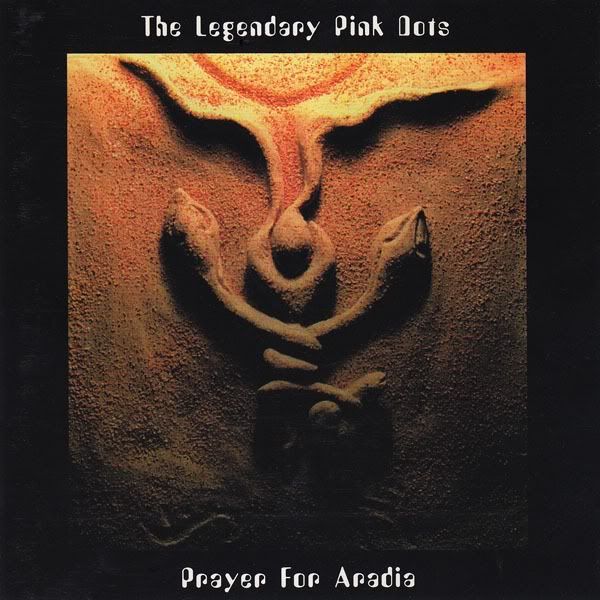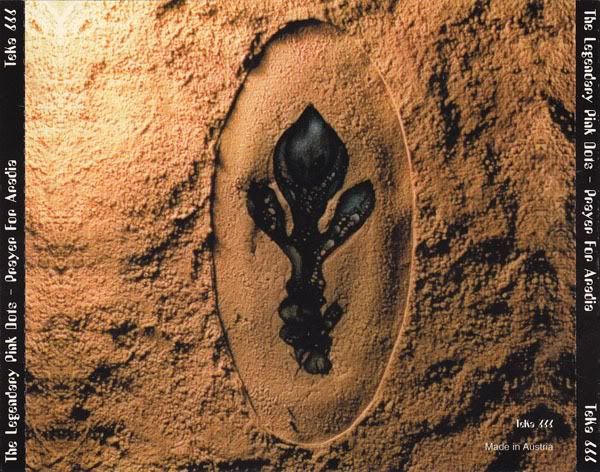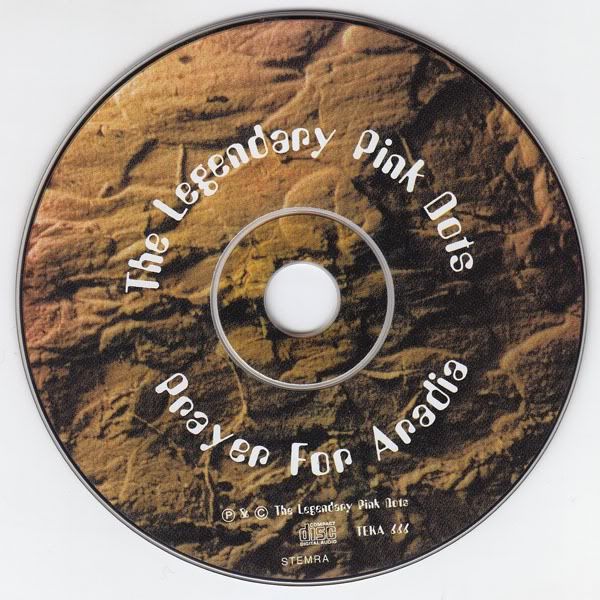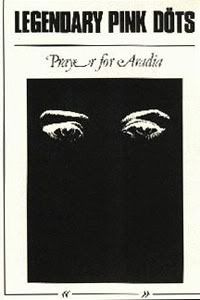Before I continue analyzing and discussing the full discography of the Legendary Pink Dots, I'd like to quickly recap where we're at. A few entries back, when first crossing into 1982 on the LPD timeline, I suggested that the band would release four cassettes in a year's time and since then I have written about four cassettes: Brighter Now, which evolved into the Dots' debut LP; Premonition, a collection of low-key pop songs kept intact on the 1997 archive CD, Under Triple Moons; and the electronic/experimental sister releases Atomic Roses and Apparition, which appear together on a CD called Traumstadt 1. So, theoretically, I should now be moving on to 1983, and discussing the Dots' pivotal second LP. Why, then, am I about to write about yet another cassette via the CD release that contains it?
Prayer for Aradia

* These tracks appear on the 1985 cassette Prayer for Aradia
** These tracks appear on Chemical Playschool 1+2
First of all, Prayer for Aradia is an extremely unique item in the Dots' catalog and I am thrilled to be able to revisit it, as well as describe it, in some way that fits into the overall narrative of the band's work. The most unusual thing about it is its original release date. Even though the tracks themselves were recorded in 1982, supposedly the tape itself did not actually see the light of day (on the French label Bain Total) until 1985. Three years at this point in their career inevitably meant a lot of forward progression, so instead of releasing just another compilation of outtakes and tracks that for whatever reason weren't considered for proper LP release, the Dots decide to heavily mix and crossfade the tracks together into side-long sequences. While this isn't a new concept for them, it is exercised somewhat more extremely here. (I tried to digitally separate the individual songs using a sound editor, and it absolutely does not work.) Something about the song selection also seems more sophisticated than the band's 1982 work would reflect; perhaps by the time of the tape's release, the play order had been tailored to compliment what the band were doing on their LPs at that time, rather than three years before. But all of this is assumption on my part, as I try to make sense of this singular oddity in the catalog and why, if you played it for me blind, I might think it originated from 1983/84.
When Prayer for Aradia was released on CD in 1996, each side-long sequence was indexed to a single track position, so that the entire contents of the original cassette make up tracks 1 & 2. The rest of the CD was padded out with 8 tracks salvaged from Chemical Playschool 1+2 and a track ("Premonition 5") that had been licensed out to a various artists compilation, plus a couple of otherwise unreleased pieces from the same early era. While this may sound like a haphazard collection, especially after the logical sense behind an archival release like Traumstadt 1, at the time of its release in 1996 there simply had been nothing like this in the Dots' oeuvre. The fact that the band were willing to start digging into their deep past and putting some of those legendary cassette tracks out on disc for greater market consumption was a shocking, welcome development, and it wiped the slate clean for endless future possibilities. Now that they had begun to re-release these tracks, how much further could they go? Would everything eventually see an official release? My friend and I began to pore over the text discography documents that were available online, reading track titles, laughing about them, wondering about them, and having no idea what to expect. We were kind of obsessed with the details, but I absolutely miss those days.
[Discography note: Yes, I am aware that other cassette tracks had seen LP and CD release on The Legendary Pink Box in 1989, but that particular release was designed and intended to be a retrospective. Its architecture feels like an attempt to reiterate the past while also closing the door on it. Its message says that old songs could at any time get reabsorbed into the Dots' ongoing development, which has always proven to be true, but it does not signal any kind of opening of the past for further evaluation. Work presented as "the best of the early cassettes" unfortunately has the unintended side effect of quietly discrediting the work that was not selected. Prayer for Aradia does not feel like this at all. It represents one piece of artwork in the gallery, not the entire exhibition.]

Prayer for Aradia tray card (above) and disc (below)

So despite its haphazard selection, the Prayer for Aradia CD at the time represented an endless number of potential future collections and it was unclear whether or not the backlog of cassette tracks would be divided up on these thematically, chronologically, or according to some Dotsian logic than we are never meant to understand. In this case, the appearance of a handful of tracks from Chemical Playschool 1+2 allows us to put that earliest era behind us, which I know I keep promising. But the complete tracklisting also plays in such a way that one can almost catch a glimpse of that untouchable Dotsian logic. Let me see how well I can explain it...
 The compilation immediately launches with the cassette portion of the program, which despite the presence of twelve track names is really only six substantial songs—some of which now rank as early Dots classics—plus the interstitial bits that link them all together. The sequence begins with "Premonition 8," about 90 seconds of cosmic synth sounds, starting with an imperial death march of sorts, some Poltergeist samples, and a hyper blast of white noise that could represent something taking off, in this case the Prayer for Aradia cassette. This really is not a song, but it doesn't have much to do with the moodier "Premonition" pieces that have been littered throughout the last three releases. The blast sounds die out as the bouncing staccato rhythms of "Flesh Parade" fade in. In a lot of ways, this song represents the erotic awakening of the Legendary Pink Dots, as it seems to consider the daily grind (ahem) of the sex trade but does so in a typical detached manner that never seems lewd despite some explicit references ("The longing thighs say come in for a night...", "She likes a man, but a hand's just as effective," etc). All in all, "Flesh Parade" boasts one of the Dots' fullest and most memorable melodies and would continue to be rearranged and re-recorded for several more years. In fact, this song is one example of how the recording of this material would almost fit into the LPD timeline better in 1985 than 1982. On the other hand, "Purity" has the amateurish sound of earlier Dots. It gallops into the mix rather quickly just as the arty outro of "Flesh Parade" finally starts to fade. "Purity" is much rockier than other tracks from this era, dependent on guitar and drums, and progressive in its arrangement; imagine Led Zeppelin's "Immigrant Song" with very little machismo and more of a hippie feel. The song drops off suddenly in a burst of disorienting keyboard noise and muted human howls that approximate the sound of someone in freefall. This lasts about ten seconds and is called "Purified." "Forgotten" is built upon arpeggiating synth chords that create a loopy kind of beauty; this is the beginning of a formula that the Dots (and especially Edward Ka-Spel) would employ for many years to come. The song personifies the forgotten mythological hero in the form of a weary King Arthur, mourning in a crypt for his glory days, and it introduces a motif of "tired eyes" that would follow Ka-Spel's career as well. The first half of the Prayer for Aradia sequence ends when "Forgotten" is juxtaposed with 30 seconds of dissonant piano tones, oddly entitled "Davritt."
The compilation immediately launches with the cassette portion of the program, which despite the presence of twelve track names is really only six substantial songs—some of which now rank as early Dots classics—plus the interstitial bits that link them all together. The sequence begins with "Premonition 8," about 90 seconds of cosmic synth sounds, starting with an imperial death march of sorts, some Poltergeist samples, and a hyper blast of white noise that could represent something taking off, in this case the Prayer for Aradia cassette. This really is not a song, but it doesn't have much to do with the moodier "Premonition" pieces that have been littered throughout the last three releases. The blast sounds die out as the bouncing staccato rhythms of "Flesh Parade" fade in. In a lot of ways, this song represents the erotic awakening of the Legendary Pink Dots, as it seems to consider the daily grind (ahem) of the sex trade but does so in a typical detached manner that never seems lewd despite some explicit references ("The longing thighs say come in for a night...", "She likes a man, but a hand's just as effective," etc). All in all, "Flesh Parade" boasts one of the Dots' fullest and most memorable melodies and would continue to be rearranged and re-recorded for several more years. In fact, this song is one example of how the recording of this material would almost fit into the LPD timeline better in 1985 than 1982. On the other hand, "Purity" has the amateurish sound of earlier Dots. It gallops into the mix rather quickly just as the arty outro of "Flesh Parade" finally starts to fade. "Purity" is much rockier than other tracks from this era, dependent on guitar and drums, and progressive in its arrangement; imagine Led Zeppelin's "Immigrant Song" with very little machismo and more of a hippie feel. The song drops off suddenly in a burst of disorienting keyboard noise and muted human howls that approximate the sound of someone in freefall. This lasts about ten seconds and is called "Purified." "Forgotten" is built upon arpeggiating synth chords that create a loopy kind of beauty; this is the beginning of a formula that the Dots (and especially Edward Ka-Spel) would employ for many years to come. The song personifies the forgotten mythological hero in the form of a weary King Arthur, mourning in a crypt for his glory days, and it introduces a motif of "tired eyes" that would follow Ka-Spel's career as well. The first half of the Prayer for Aradia sequence ends when "Forgotten" is juxtaposed with 30 seconds of dissonant piano tones, oddly entitled "Davritt."Side two of the original cassette begins with pounding drums and funky shards of post-punk guitar. Could this be a Gang of Four track? No, the undeniable declaration that follows makes it rather clear that this is the Legendary Pink Dots, playing with brute force: "Excommunicate the heretic! Chain up, crucify the lunatic, the fanatic!" Though labeled "Outsider" here, the song would soon become immortalized under a different name as one of the Dots' best early live tracks. About a minute of multiple layers of manic backward vocals ("Invocation") acts as a transition into "Love in a Plain Brown Envelope." If "Flesh Parade" was the sexual awakening of the band, this song is the loss of its virginity. The song is built upon low electronic pulses and orgasmic chants, almost certainly influenced by the retrofuturism of Barbarella and similar sci-fi themed sexcapades. "Heaven is a hole, there's a whole lot of heaven in your cavern," indeed. It's a massive track and a milestone in the band's ability to make complex creations out of sounds where there may not be much of a song. "Love on a Stained Glass Window" is a brief tape loop experiment that electronically approximates the sound of a thunderstorm, but it serves more to drown out the previous song than it does to make a satisfying transition. Instead of fading in gradually, "Space Captain" starts rather cold, immediately pulling the mood down considerably. It takes the shuffling, exotic backing track from Brighter Now's "City Ghosts" and slowwwws it dowwwwwn. It also features all-new lyrics, about suicide as self-medication for despair. Ka-Spel reaches an all-time sinister low here, as he takes the role of the devil urging on the dose: "Take them now! Take them now! You can be anything you want to be!" The psychology behind the song fits beautifully with its psychedelic overtones, offering the sort of anthem that someone like Syd Barrett would have been too afraid to do. The sequence comes to an end with "Premonition 9," which offers the brief after-hours ambience of a jazzy sax solo coming from down the hall.
At this point, any good discography geek should be asking about those "Premonition" tracks. After all, "Premonition 1" and "Premonition 2" are on Under Triple Moons, "Premonition 3" is on Traumstadt 1 and "Premonition 4" is on Brighter Now. But suddenly this release skips up to "Premonition 8". Where are the others? Of course the Dots are never predictably straightforward, but they might have considered this rhetorical question as this CD was being compiled, because "Premonition 5" features as its first bonus track, and it makes an excellent, logical transition. (Its only previous appearance was on a various artists compilation that was released sometime in 1983.) This installment in the series is much more in line with the premise of the first four tracks, a moody sort of thing that is built around an established sample or altered form of a pre-existing recording. In this case, the track has been developed into a lovely 11-minute tour de force of quiet beauty and new ideas, as it presents both an instrumental version of a romantic, medieval string piece called "Time Dance" and a backwards version of the early LPD classic "Voices." New lyrics have been written and recorded over the "Voices" part, demonstrating how "Premonition" tracks don't have to stop at simply creating moods and can instead evolve into something else entirely.
Two previously unreleased tracks complete the transition into the Chemical Playschool 1+2 material. The first is an instrumental electronic piece built upon short breaths of synth noise and a Spanish-style guitar lick. It is suitably called "A Spanish Bridge," for that's exactly what it is. This leads directly into "Stoned Obit 1980," i.e. a version of "Stoned Obituary" earlier than the one found on Kleine Krieg. It opens with arrhythmic cut-up electronic horns that could easily be mistaken for a tornado warning or an air raid siren, but quickly becomes the sort of manic keyboard number that often overwhelmed the band's earliest tapes. It's difficult to imagine why this hadn't seen any kind of release prior to this, as it's clearly a finished recording with the vocal narrative firmly in place. The melody here has not yet developed the aspects the song shares with "City Ghosts," but that's not necessarily a detriment. This version also doesn't have the ever-changing backdrop that is present in later versions.
The rest of the bonus material on this CD was covered in previous blog entries. Meanwhile the song "Stoned Obituary" was soon to become one of the monumental bookends on the Dots' second LP, Curse.
<----- GO BACKWARD to Traumstadt 1

2 comments:
Oh God I never realised Space Captain is City Ghosts & I've sped the slow version from rising from the red sands up to see if it's thwe same one they used in the box set.There you go.
Oh God I never realised Space Captain is City Ghosts & I've sped the slow version from rising from the red sands up to see if it's thwe same one they used in the box set.There you go.
Post a Comment